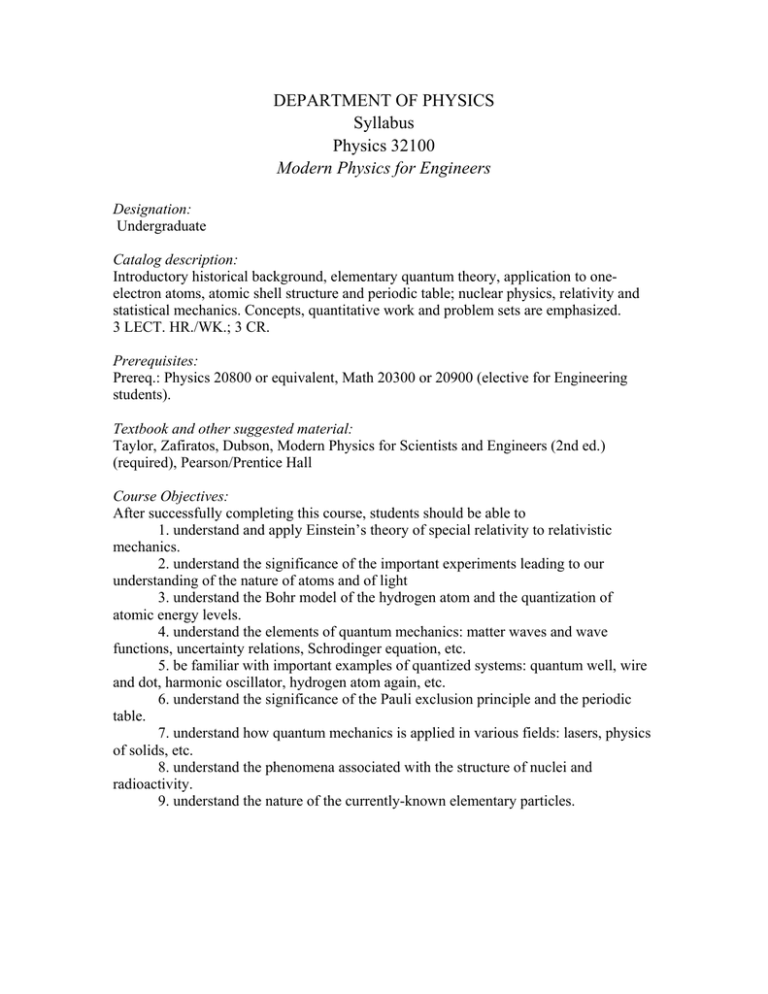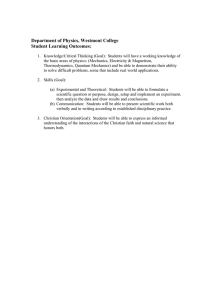
DEPARTMENT OF PHYSICS
Syllabus
Physics 32100
Modern Physics for Engineers
Designation:
Undergraduate
Catalog description:
Introductory historical background, elementary quantum theory, application to oneelectron atoms, atomic shell structure and periodic table; nuclear physics, relativity and
statistical mechanics. Concepts, quantitative work and problem sets are emphasized.
3 LECT. HR./WK.; 3 CR.
Prerequisites:
Prereq.: Physics 20800 or equivalent, Math 20300 or 20900 (elective for Engineering
students).
Textbook and other suggested material:
Taylor, Zafiratos, Dubson, Modern Physics for Scientists and Engineers (2nd ed.)
(required), Pearson/Prentice Hall
Course Objectives:
After successfully completing this course, students should be able to
1. understand and apply Einstein’s theory of special relativity to relativistic
mechanics.
2. understand the significance of the important experiments leading to our
understanding of the nature of atoms and of light
3. understand the Bohr model of the hydrogen atom and the quantization of
atomic energy levels.
4. understand the elements of quantum mechanics: matter waves and wave
functions, uncertainty relations, Schrodinger equation, etc.
5. be familiar with important examples of quantized systems: quantum well, wire
and dot, harmonic oscillator, hydrogen atom again, etc.
6. understand the significance of the Pauli exclusion principle and the periodic
table.
7. understand how quantum mechanics is applied in various fields: lasers, physics
of solids, etc.
8. understand the phenomena associated with the structure of nuclei and
radioactivity.
9. understand the nature of the currently-known elementary particles.
Topics Covered:
1. Einstein’s theory of special relativity; relativistic mechanics
2. Important experiments that have led to our current understanding of the nature
of atoms and of light, e.g, Millikan oil drop, black-body radiation, Rutherford
backscattering, photoelectric effect, etc.
3. Bohr model of the hydrogen atom; quantization of energy
4. Elements of quantum mechanics: matter waves and wave functions, uncertainty
relations, Schrodinger equation, etc.
5. Examples of quantized systems: quantum well, wire and dot, harmonic
oscillator, hydrogen atom again, etc.
6. Pauli exclusion principle and the periodic table
7. Applications of quantum mechanics: lasers, physics of solids, etc.
8. Nuclei and radioactivity
9. Elementary particles
Class schedule:
3 LECT. HR./WK.; 3 CR.
Relationship of course to program outcomes:
The outcomes of this course contribute to the following departmental learning
outcomes:
a. students will be able to synthesize and apply their knowledge of physics and
mathematics to solve physics-related problems in a broad range of fields in classical and
modern physics, including mechanics, electricity and magnetism, thermodynamics and
statistical physics, optics, quantum mechanics, and experimental physics.
c. students will be able to communicate their knowledge effectively and in a
professional manner, in both oral and written forms.
Person who prepared this description and date of preparation:
Prof. F. W. Smith
email address: smith@sci.ccny.cuny.edu
date: 9/10/2007
Academic Integrity and Plagiarism
The CUNY Policy on Academic Integrity can be found at
http://web.cuny.edu/academics/info-central/policies/academic-integrity.pdf
This policy defines cheating as “the unauthorized use or attempted use of material,
information, notes, study aids, devices or communication during an academic exercise.”
The CUNY Policy on plagiarism says the following about plagiarism (the CUNY Policy
can be found in Appendix B.3 of the CCNY Undergraduate Bulletin 2007 -2009 as well
as the web site listed above):
Plagiarism is the act of presenting another person’s ideas, research or writings as your
own. The following are some examples of plagiarism, but by no means is it an exhaustive
list:
1. Copying another person’s actual words without the use of quotation marks and
footnotes attributing the words to their source.
2. Presenting another person’s ideas or theories in your own words without
acknowledging the source.
3. Using information that is not common knowledge without acknowledging the source.
4. Failing to acknowledge collaborators on homework and laboratory assignments.
5. Internet plagiarism includes submitting downloaded term papers or parts of term
papers, paraphrasing or copying information from the internet without citing the source,
and “cutting and pasting” from various sources without proper attribution.
The City College Faculty Senate has approved a procedure for addressing violations of
academic integrity, which can also be found in Appendix B.3 of the CCNY
Undergraduate Bulletin.”



